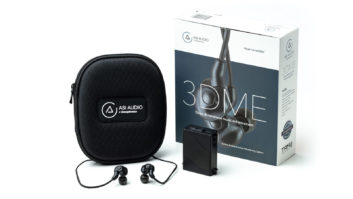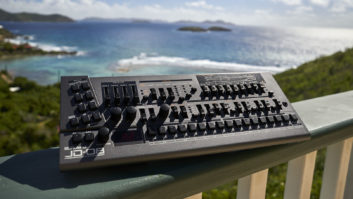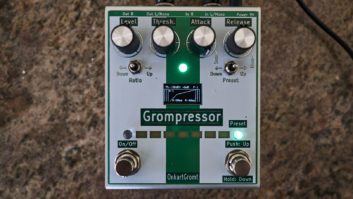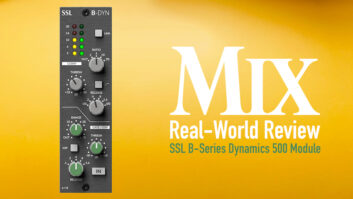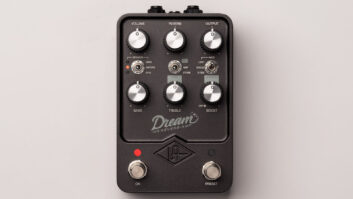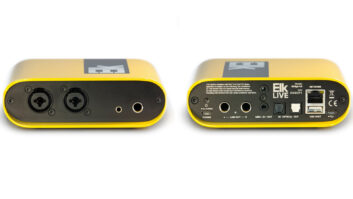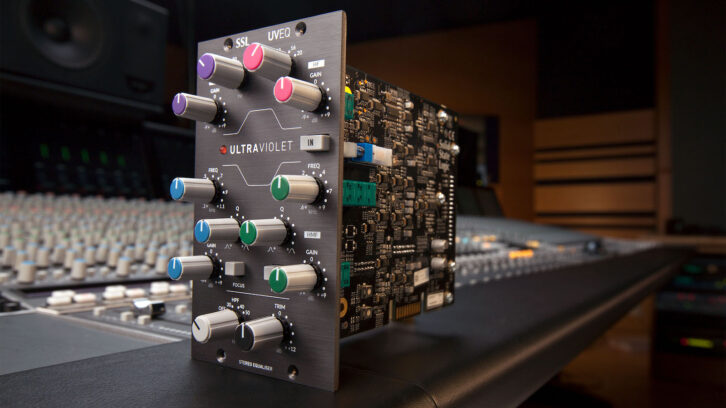
| MIX VERDICT: SSL Ultraviolet Stereo EQ |
| THE TAKEAWAY: “If you don’t have a proper stereo EQ, this is a good choice, and I can highly recommend it.” |
| COMPANY: Solid State Logic • www.solidstatelogic.com PRICE: $1,299 PROS: • Lots of power and utility in two 500 slots. CONS: • Lack of markings for Gain knob values. |
SSL continues to offer many of its popular hardware processors in an ever-growing line of 500 Series modules, recently adding the single-channel SiX channel strip, an enhanced VHD+(Mic) Pre module and now the Ultraviolet Stereo Equalizer.
Packaged in a compact, dual-slot 500 module, the Ultraviolet Stereo EQ is a minimum phase-shift equalizer with four sections. At the top of the front panel is the 2-band Hi/Lo shelving equalizer taken directly from the Violet EQ section of the Solid State Logic Fusion analog 2U rack-mounted processor. Like the Fusion, this is a first-order shelving filter that works like a “broad brush” tone control—a final touchup EQ for mixes, mix stems or any stereo audio. This section is a fixed shelf with no Peak (bell-shape) button.
The section’s low-shelf frequency section has 30 Hz, 50 Hz, 70 Hz and 90 Hz frequency choices and its own Gain control for up to ±9 dB of boost/cut. The high-frequency half of this shelving EQ has four frequency choices: 8 kHz, 12 kHz, 16 kHz and 20 kHz, plus its own Gain control for ±9 dB.
All Gain or Trim controls on the UV EQ have solid-feeling, center-detent, 0 dB positions that serve as bypass switches for that section. There is also a single master In/Out bypass button for the entire module that’s handy for quick A/Bing.
With its own unique design, the UV EQ draws on frequencies and the tonal characters of past SSL channel strips to add two parametric mid-band sections with overlapping ranges, variable Q and a Focus feature. These mid-band sections are similar to the SSL G Series channel strip’s proportional Q EQ sections. (With a Proportional Q equalizer, the more you boost/cut, the narrower the Q gets.)
LMF/HMF SECTIONS, FOCUS
The Low Mid Frequency is continuously adjustable from 100 Hz to 1.1 kHz, while the High Mid Frequency has a sweepable frequency range of 400 Hz to 6 kHz.
Both the LMF and HMF sections have individual Focus pushbuttons for toggling between a broad Q of 0.3 and a much higher and narrower Q of about 13. While in Focus mode, the Gain range doubles to ±18 dB boost/cut at the same time. With Focus not selected, the Q knob set straight up at its midpoint serves as a default position and perfect for most EQ processing.
At the very bottom of the UV EQ module is the fourth section, an 18 dB/octave stereo highpass filter. The fixed frequencies available on a rotary switch are: Off (out of circuit), 30 Hz, 40 Hz and 50 Hz. The entire UV EQ finishes with a Trim control that has a center detent and a ±12 dB range.
IN THE STUDIO
With the UV EQ in the first two slots of my eight-slot Fix Audio Bucket 500 Series Rack, I used it as a hardware insert on my Pro Tools stereo mix bus. The UV EQ was connected in line before my Manley NuMu stereo compressor, with that entire chain returned to the HW bus insert. I wanted to do a faux mastering job to make an MP3 copy of a finished stereo mix. (Since then, this arrangement has become one of my de facto setups for this process.)
At a minimum, the UV’s Hi/Lo shelving section on entire mixes is a winner for gently brightening and filling out the low end. Boosting low frequencies can be touchy, but pushing at 30 Hz, just slightly off the detent, worked well on the whole track, while adding a bigger boost (two “dots” on the gain control) at 20 kHz added “airiness” to the track. Boosting at 20k is also touchy, and (later) I had to reduce that boost amount as the cymbals and certain vocal sibilants started to stand out too much. I kept the rest of the UV on detents and the master Trim at unity.
Joe Chiccarelli Signature Plug-in – A Real-World Review
On another song, I tried the UV EQ on individual tracks. Here, I was immediately reminded of using the EQs when mixing on an SSL console—the controls all do what they do well. For distorted electric guitars playing through my pair of old Western Electric 111C transformers, I wanted to “recover” some lost lows that those transformers usually remove. Once again, the UV Hi/Lo section worked great with a boost at 70 Hz, which seemed to match the sound closer without the transformers inserted.
FOCUS FIXING
I wanted to learn the Focus feature. I had a mono (real) piano track that had a certain “boxy” frequency around 1 kHz that was necessary and part of the overall sound, but it produced an annoying resonant peak only during the choruses.
To find and deal with this problem, I pushed in the Focus button in the HMF band and changed the Q control to full counter-clockwise—the narrowest and sharpest position—and then cranked up the Gain to full clockwise. By sweeping the HMF’s frequency control around, the offensive 1 kHz area smacked me right in the face!
I ended up keeping the Focus button in, widening out the Q a little to sound more natural, and then cutting the Gain to about -3 dots. I wish the Gain controls had an actual value printed at midway, but the dots are convenient visual reference markings for the relative amount of boost/cut, frequency or Q knob settings. It is not possible to have actual dB printed because of front-panel space limitations. Even so, the Q settings of the filters and whether Focus mode is in/out will dictate the actual values. (I take pictures for recalls anyway.)
I debated going out of Focus mode to get a smoother, more high-fidelity piano sound. Instead, I kept Focus in and finished this piano track’s sound by using the Hi/Lo section to lift the high frequencies at 16 kHz, with just a touch to the bottom end at 50 Hz.
RECORDING WITH THE UV EQ
Next, I used the UV EQ to record a Donner Rising-G Pro Carbon Fiber acoustic guitar. I used an X/Y stereo configuration with two Neat Microphones cardioid condensers placed out front about six inches and over the 12th fret. The mics fed a pair of Sunset S1P Tutti Mic preamps connected to the UV EQ, whose outputs were driving an API 529 Stereo compressor/limiter. This entire stereo chain occupies six slots in a 500 rack and works great for a portable stereo recording rig!
Listening to the Donner reminded me of an Ovation acoustic—a bright-sounding guitar, but a little thin in the low frequencies. I again used the UV EQ to “warm up” the overall sound by boosting, dialing the LMF section at 200 Hz and normal Q.
There was a certain area covered in the overlapping HMF’s range where I did use the Focus mode to “carve” out a 400 Hz peak that occasionally triggered instantaneous gain reductions in the API 529 at the end of the chain.
I found that getting a good EQ was fast and easy while the musician was on-mic and playing. By using the Ultraviolet Stereo EQ every day in mixes, I was quickly acquainted with it for recording. It’s an awesome amount of power in just two 500 slots! If you don’t have a proper stereo EQ, this is a good choice, and I can highly recommend it.
